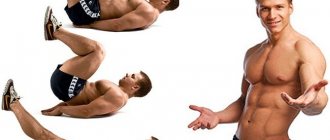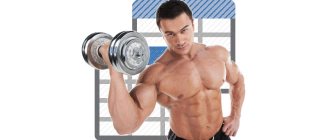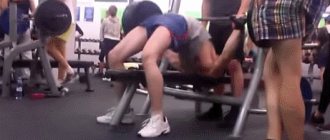Stretching after a workout is an integral part of the workout itself. It not only helps muscles grow and strengthen, but is also a good prevention of injuries. Stretching, especially after training, is the key to flexibility, correct posture and good mood. Any competent coach will tell you about this. It is especially important to stretch for young children; at the gymnastics center, trainers always monitor this; reviews from https://krepysh.com/otzyvy.html from parents only confirm well-organized work.
Why do you need stretching?
There are many reasons.
For example, oversized muscles are thought to interfere with normal movement, and bodybuilders are extremely inflexible to effectively stretch after strength training. However, this is nothing more than a myth - the smoothness and ease of movements does not depend on the volume of muscles.
Physiology of the process. Your muscles actively contract during cardio or strength training. After completing the workout, the loaded areas of the body remain clamped for a long time. The subsequent gradual restoration of muscle length is called rest. Until the muscle regains its length, it has not rested. To speed up the recovery process, it is most effective to apply a set of stretching exercises to all affected body groups.
Athletes begin to lose flexibility due to lack of appropriate regular exercise. Of course, some people are initially more flexible from childhood, but this is not an excuse. Stretching has a positive effect on any person - from children to the elderly. It is best to stretch regularly, performing special complexes, both before and after training or on rest days.
In addition, stretching in bodybuilding brings many benefits, for example, it perfectly warms up and calms the muscles, and also improves muscle coordination, prevents long-term muscle pain and speeds up recovery. You will feel more energetic and improve your body's capabilities.
Basic rules for stretching
Muscle stretching after training is performed according to the following rules:
- Performed only on warmed muscles
At the end of the activity there is no problem with this. But remember, the sooner you start stretching, the better. Otherwise, you risk “cooling down” and getting injured.
- Static flexibility exercises are used.
Each pose is held in a state of maximum tension for 15-60 seconds, depending on the level of training. Start with short periods of time and gradually increase the time.
- Stretch the muscles that took part in the movement
You can perform stretching for the main muscle groups, but special attention should be paid to those that have been subjected to stress.
- The strength of static muscle stretching increases gradually
To avoid stretching or injuring ligaments and tendons, add load gradually, exerting moderate pressure on the muscles.
- Loads used from simple to complex
In the stretching complex, the easier flexibility exercises come first, and then the complexity increases.
Bodymaster.ru recommends Training Plans:
Stretching prevents stiffness. Over the years of training without high-quality regular stretching, the athlete’s muscles “remember” their shortened length and get used to it.
Muscle contraction and relaxation are two sides of the same process. As much as it can stretch, it can shrink further. If the muscle has not been stretched, it will contract less well, which will cause stagnation in strength results. We offer a simple set of exercises in a video program.
Also, stretching exercises prevent various injuries. According to statistics, athletes who regularly stretch are half as likely to suffer sprain-related injuries. If these professional guys take stretching responsibly, isn't it time for you to think about it too?
Does stretching improve recovery?
Before discussing the possibility of improving recovery from stretching, just remember that other post-workout modalities—heat, cold, vibration, massage, hydrotherapy, pain medications, and foam rolling—have been shown to reduce muscle soreness and increase ASD; thus, improved recovery (9 – 17).
Blood flow during and after stretching
During static stretching there is a decrease
blood flow, regional capillary oxygenation, and the rate of red blood cell entry into muscle (18–21).
This is perhaps to be expected, since the tension resulting from the mechanical stress on the muscles from stretching can cause the vessels to contract and elongate. However, immediately after stretching, blood flow increases significantly compared to previous levels (16).
Thus, static stretching appears to produce an intermittent effect on muscle blood flow, that is, it decreases flow during the stretch but quickly increases it afterwards.
A temporary decrease and subsequent increase in blood flow may promote recovery by improving nutrient delivery while removing metabolites, but this has not yet been confirmed by research.
Muscle soreness and strains after exercise
Although many independent studies have been conducted on the effects of stretching on muscle soreness (some (11) had positive results), almost all studies are rated as low to moderate in quality (2). According to a meta-analysis on the topic that included more than 2,500 subjects, stretching for recovery after exercise reduced the appearance of muscle soreness by 1 to 4 points on a 100-point scale. Although the indicator is statistically significant, the effect is very small and almost invisible.
Unfortunately, despite the long history and frequent inclusion of this recovery strategy in many training programs, static stretching after exercise has little effect on muscle soreness.
Parasympathetic modulation
The autonomic nervous system consists of two branches:
- Sympathetic
Nervous System (SNS) - Parasympathetic
nervous system (PSNS)
The simplest way to describe the differences between them is to associate SNS with mobilization and strengthening, and PCNS with rest and relaxation. Thus, the SNS increases the heart rate, while the PCNS slows it down.
Essentially, the PSNS helps facilitate recovery from a stressful event (such as competition or training) by counteracting the effects of the SNS, which increases arousal and readiness (22).
Taking this into account, PSNS is associated with systemic (whole) relaxation. Relaxation, which reduces the activity of the PSNS, is an important component of restoration and rejuvenation of hemostasis and adaptation after training.
Static stretching has been shown to increase both short-term (same day) and long-term (over several weeks) modulation of the PSNS (i.e., activity), as measured by changes in cardiac activity (i.e., heart rate variability) (23–28 ).
Performing static stretching daily for 15 minutes, consistently for 28 days, may improve heart rate variability (28). As a result, static stretching appears to be a useful tool for increasing PSNS activity and therefore promoting relaxation.
Range of motion (range) and post-workout stretches
Mobility
usually refers to the range of motion (range of motion) in a joint or joint system (such as the spine). Static stretching methods are perhaps the most commonly used to develop or increase joint flexibility, especially after training.
It should be understood that there is a distinction between “stretching,” which is commonly used to improve flexibility, and “range of motion” exercises, which are more commonly referred to as “mobility exercises” (29).
Stretching
post-workout is most often used by coaches and athletes to restore pre-workout ranges of motion rather than improve flexibility. Research has shown that static stretching can improve joint flexibility (30–37), but the mechanism is still not entirely clear.
Because some studies have failed to show that stretching can improve tissue length (eg, musculotendinous), it has been suggested that increased flexibility results from improved tensile strength (ability to withstand stretching) rather than tissue extensibility (eg, increased muscle length ) (38-42).
Despite this assumption, new, higher quality evidence demonstrates that static stretching can improve flexibility by changing mechanical factors associated with tissue stiffness (43).
Thus, static stretching improves flexibility and does this by increasing the passive length of the fascicle and decreasing the passive angle of the fascicle (a muscle has an actively contracting part - the belly and a passive part with which it is attached to the bones - the tendon).
To this should be added that static stretch reduces nerve excitability by 16-88%, observed by changes in the spinal reflex and H-reflex responses (44). The increase in flexibility can also be explained by a decrease in neuronal excitability (44).
As a result, static stretching may also improve flexibility by decreasing nerve excitability, in addition to changing the mechanical structures of the musculotendinous system (band length and angle).
When to do stretching exercises
It is best to stretch the muscles after a short warm-up or workout, when they are well warmed up or too tired to resist stretching.
Make it a rule to do the suggested exercises after every strength or cardio workout. Weight training makes muscles hard and inflexible. When working with heavy weights, micro-tears of muscle fibers occur. Within 24-73 hours after training, the body restores them, causing them to become stronger and fuller. By performing appropriate recovery exercises on the day of your workout, you will loosen your muscles and also develop flexibility (provided you do it long enough and often enough).
You can stretch at home in the evening after training. For many active athletes, this is an ideal option, as it does not require special equipment. The more you stretch throughout the day, the more flexible your muscles will be and the easier it will be for you to maintain flexibility in the future.
Basic set of exercises
The main elements of body stretching for beginners after strength training should be the following:
- It is better to start stretching while sitting. Spreading your legs as wide as possible, you need to reach for each toe in turn.
- The next element should be this: from the same position, you need to bend one leg at the knee and reach with your hands to the toe of the second leg.
- From the “sitting on your knees, resting your buttocks on your heels” position, slowly bend forward.
- We stand on our feet, placing them shoulder-width apart. We cross our arms behind our backs. Bringing the same arm and leg forward, we make a wide lunge and spring on the leg for 15 seconds. We change sides.
Men and women need to add a number of elements to the set of exercises, which are presented in the table.
| Man | Woman |
| From a standing position, we extend our right arm to the side, grabbing the left toe of the foot and pressing it to the buttock. Delay 10-15 seconds. Change of legs. | We stand on our feet and place our palms on our heads. We bend the neck back and forth. |
| Side lunges. | We clasp our hands behind our backs and stretch them as far as possible until we feel pain. |
| We kneel down and lean forward, maintaining balance. Ideally, your forehead should touch the floor. | We take the elbow of the opposite hand with our palm behind our back and pull it until we feel pain in the joints. Change of hands. |
| We stand on the bridge from a lying position. |
We complete the complex with two elements:
- we sit on the floor and bring our legs together, slowly bend towards our toes;
- We spread our legs to the sides and lean forward, sliding our palms along the floor.
This stretching can be done after every strength or cardio workout. Exercises in the gym require deeper muscle development, which needs to be devoted to at least 30-40 minutes. In this case, it is necessary to consistently stretch all muscle groups: from the neck to the legs.
Bodymaster.ru recommends Fitness Trainers:
Stretching exercises after training are done statically without sudden body swaying or jerking.
After a delay in the working position, when the muscles have become accustomed to the position of the body, you can begin progressive stretching. From a position of light stretching, you need to gradually move forward until you again feel a slight stretch in the muscle. Hold again for 10-30 seconds. The voltage will decrease slightly. Again, if you feel discomfort or pain in your muscles, you need to ease up to the point of comfort.
Remember to breathe. Breathe naturally while doing the exercises. Do not hold your breath, as this interferes with relaxation and is not beneficial. To avoid sudden movements that cause contraction of muscle fibers, breathe slowly and rhythmically. The exhalation force helps to better relax the muscle and enhances the effect. Additionally, try exercises with a massage roller. They will become indispensable for a deeper study of the fascia.
Incorrect technique
Discomfort or pain means you are stretching incorrectly, such as springing. The body responds better when completely relaxed. Pain and discomfort cause tension. It is better not to stretch through the pain, this can lead to rupture.
Why do you need to stretch after a workout?
Let's look at why you need to stretch after a workout. After physical activity, the muscles are loaded and exhausted, they are in a state of hypoxia, and may hurt. Thanks to stretching, blood flow is distributed evenly, and decay products are eliminated faster. It helps relieve muscle fatigue and relieve pain. Stretching also helps you recover faster and form the correct shape of your figure.
Why do men need stretching after exercise?
To get maximum results from sports, you need to start, conduct and end your training correctly. Stretching helps increase endurance, strengthens joints, and increases range of motion. If muscles are subjected to high loads, they shorten and thicken over time. In representatives of the stronger sex, they are tough in themselves, which is why strength training gives more tangible results. Due to overstrain and overheating of the muscles, joint mobility may decrease, which reduces the effectiveness of the exercise.
Most men who are not professional athletes exercise in order to gain muscle definition, improve endurance and health. Why does a man need stretching after a workout? It helps release tissue for muscle growth. By stretching, you will again speed up blood flow in your muscles. Lactic acid will begin to leave, the connective tissue will give way to muscle fibers. Stretching helps you relax and provides additional oxygen not only to your muscles, but also to your internal organs. It helps normalize blood pressure, increase the strength of ligaments and joints, and prevent diseases that are accompanied by the deposition of salts in the joints.
In men who stretch after training, arthritis and arthrosis are three times less likely than in those who do not stretch.
Why do girls need stretching after training?
Women for the most part go in for sports not in order to strongly pump up their muscles, but in order to strengthen them, maintain a slim figure and tone the body. Stretching after training for girls helps improve athletic performance, strengthens ligaments and joints, and prevents possible injuries. In addition, such exercises are a great way to improve flexibility, gracefulness and sexuality, and get an attractive figure.
For a woman, muscle shortening will be an aesthetic problem. In addition, this increases the risk of injury due to careless movements or walking in heels. Constant stretching improves coordination, helps repair injured muscles and improve blood circulation, and even improves self-confidence.
During menstruation, it is important for girls not to overdo it with stretching, as it increases uterine contractions and can cause severe bleeding.
Leg stretching complex
Gluteal stretch
- 10-20 seconds
- Body Part: Buttocks Equipment: No
Glute stretch (knee to chest)
- 10-20 seconds
- Body Part: Buttocks Equipment: No
Hip abductor stretch while lying on the floor
- 10-20 seconds
- Body Part: Hamstring Equipment: No
Quadriceps stretch while sitting on your knees
- 10-20 seconds
- Body part: Quadriceps Equipment: Body weight
Quadriceps stretch while kneeling
- 10-20 seconds
- Body part: Quadriceps Equipment: Body weight
Quadriceps Lunge Stretch
- 10-20 seconds
- Body part: Quadriceps Equipment: Body weight
Forward Bend Hamstring Stretch
- 10-20 seconds
- Body Part: Hamstring Equipment: No
Stretch your calf muscles with your palms against the wall
- 10-20 seconds
- Body Part: Calves Equipment: No
Stretching the calf muscles and Achilles tendon
- 10-20 seconds
- Body Part: Calves Equipment: No
Add to Calendar * Add to My Workouts * Print Workout
* — The service is in beta testing
Pay attention to the results: how do your muscle fibers feel, have they begun to recover better and faster?
Video: How to do stretching for men and girls at home after training
According to Hinduism, the body and mind are one, so the path to divine enlightenment is through equally important mental and physical exercises.
Yogis paid no less attention to the development of the body than to the cultivation of the mystical properties of consciousness. One can argue with the philosophy of yogis, but the main concept of Hinduism is confirmed by modern science: a high, healthy spirit lives only in a healthy body.
Yoga poses amaze with their gymnastic complexity, but the main condition for preparedness is not physical strength, but amazing flexibility. Yogis gave this property of the body a truly divine meaning.
Oddly enough, materialistically minded scientists who undertook to study the effect of flexibility on human health were faced with a number of inexplicable phenomena.
In particular, it turned out that the development of flexibility in mature people causes a distinct effect of rejuvenation! Regular flexibility training improves the body's hormonal levels, increases intelligence and... potency!
When and why to stretch muscles in the gym
Stretching exercises have a powerful relaxation effect for girls and men, so you should not stretch before strength training. (If only a little bit.)
Time
The time to stretch is after your workout. This is where 10 minutes of thoughtful and competent stretching movements are enough to reduce recovery time by 15-25%!
However, something else is much more important for a bodybuilder. Strength exercises strengthen joints over time. If you were a powerlifter, this would be considered a positive thing. The connective tissue coarsens, becomes thicker and thereby strengthens the joints.
However, in bodybuilding the opposite is true; loss of flexibility reduces the range of exercises.
And this prevents your muscles from growing!
According to the latest scientific concept, the growth of muscle volume is dictated by simple physical stretching of the membranes of muscle fibers.
These shells have a large supply of elasticity. Under the influence of repeated repetitions pumping blood into the working muscle, each fiber thickens, stretching its outer shell. Then the blood drains, and the elastic corset of the shell contracts, returning the fiber to its previous volume.
As you know, water wears away stones. Long-term training depletes the elasticity of the connective membranes of the fibers, and they begin to gradually stretch. As a result, the fibers become thicker and thicker, like a bicycle wheel under the influence of a pump.
What happens is what is called an increase in muscle volume. If the process is not supported by regular pumping, the muscles turn into a punctured tire.
Since we are talking about microscopic scales, it takes years to stretch the shells. For example, the path to becoming a pro takes about 10 years.
Now listen! It turns out that the biological mechanism that compresses the diameter of the fibers can be interfered with! To do this, you just need to strongly stretch the working muscle!
Think for yourself, previously the elasticity mechanism resisted only the transverse expansion of the fibers, but now it will also be forced to resist longitudinal stretching. This means that the compression forces will weaken significantly!
In short, to one type of stretching you add another. It is clear that progress will go faster this way.
Stretching is performed in the following four cases:
During the warm-up, do simple stretching exercises.
If you stretch the elastic for a few seconds, it will begin to heat up. In the same way, stretching warms up the muscles and tendons. But if you stretch the rubber band too much, it will stretch and lose its elasticity. It may even break. The muscles are very similar. You should be careful when stretching during your warm-up. In fact, medical research shows that warm-ups with prolonged stretching typically cause decreased performance. Losing even a little explosive power will cause the muscle to become less powerful because the stretch contraction cycle will be slower. This decrease in performance only lasts a few hours, but is enough to interfere with your workout. So be careful not to overdo it when you stretch during your warm-up.
Stretching exercises between sets
During exercise, stretching can cause two effects:
1. At its best, stretching allows you to quickly restore muscle strength, which helps reduce rest time between sets.
2. In the worst case scenario, stretching can exacerbate strength loss.
The explanations for these extremes are not as surprising as they might seem. They largely depend on the amount of muscle fatigue achieved during the exercise. It's even possible that stretching is beneficial between the first few sets, but then ineffective between subsequent sets. This can also be appropriate the other way around.
The advantage of stretching exercises is that you feel the benefits or disadvantages immediately after stretching. Therefore, you do not have to strictly adhere to the program regarding stretching between sets. Even if some people extol the virtues of stretching, the benefits may not be the same in every case or for every person all the time.
Post-workout stretching exercises
This is the best time to stretch, even if there is a temporary decrease in muscle performance, this will no longer affect the workout. Ideally, you need to stretch the muscles that you trained, since they are maximally warmed up. But, always keep in mind the rule that we have already described: Too much flexibility can be harmful in the long run. Just maintain the proper range of motion to avoid injury.
Between workouts - stretch the muscles of the whole body at home
Stretching exercises can speed up recovery time between two workouts. The problem with this technique is starting with cold muscles, which is very dangerous. However, contrary to popular belief, stretching between workouts does not always help the muscle recover.











